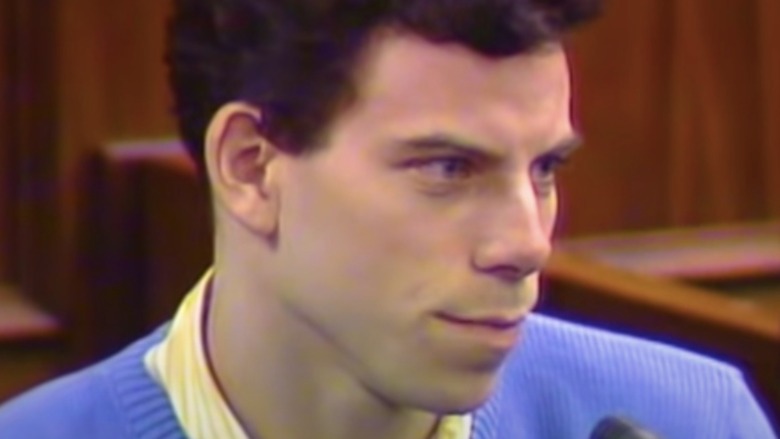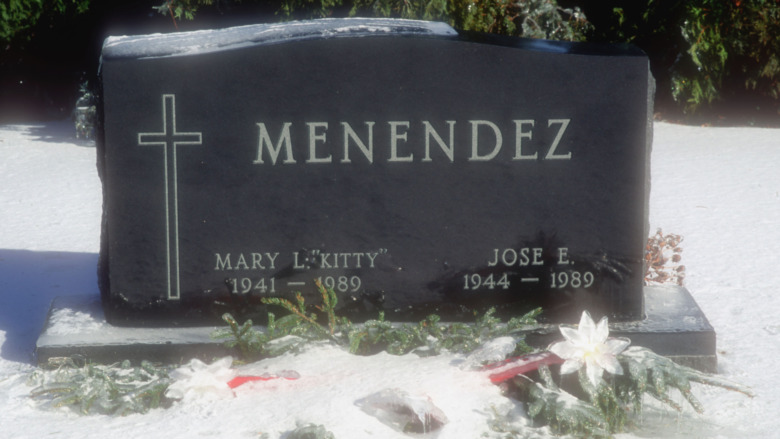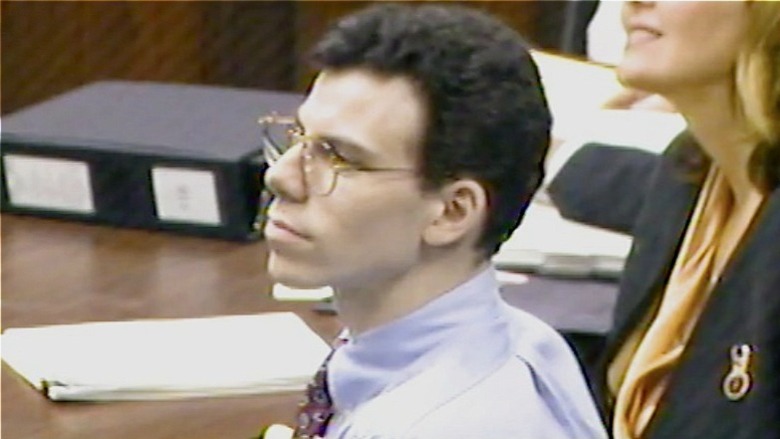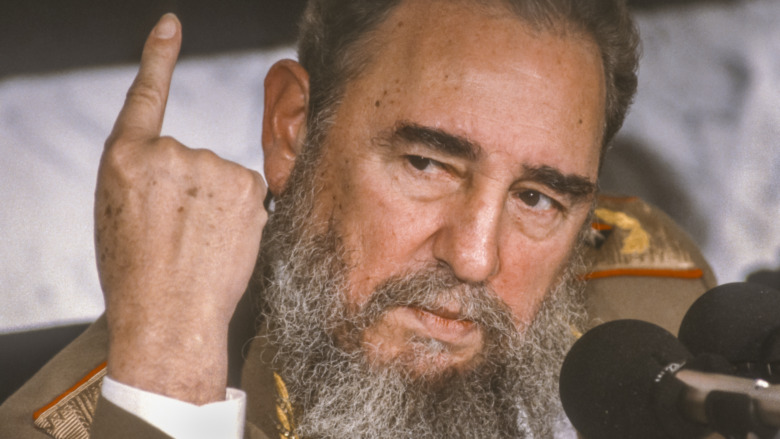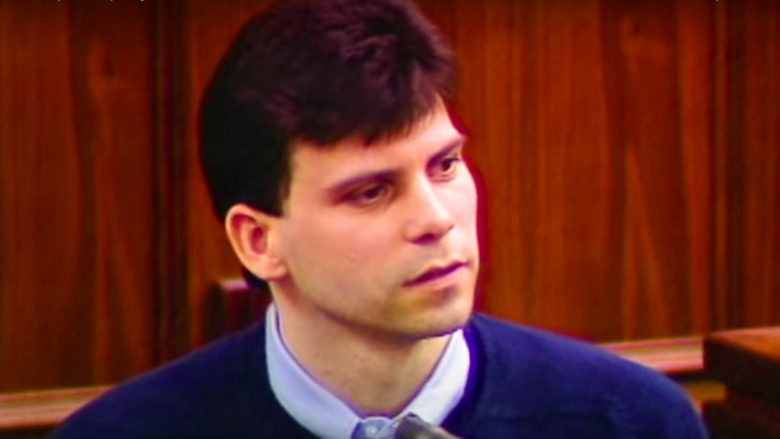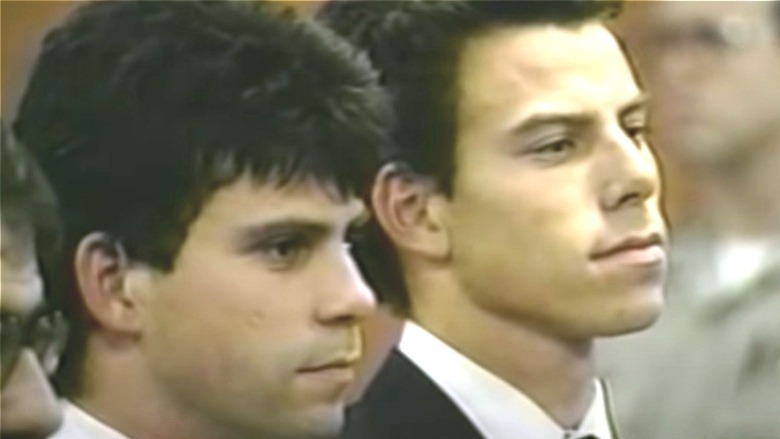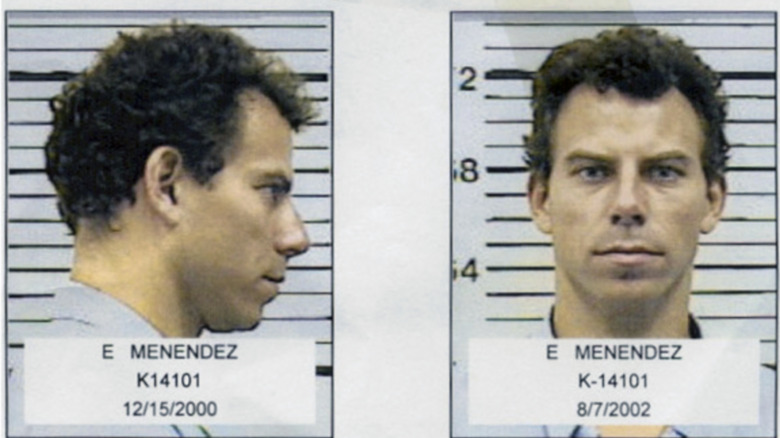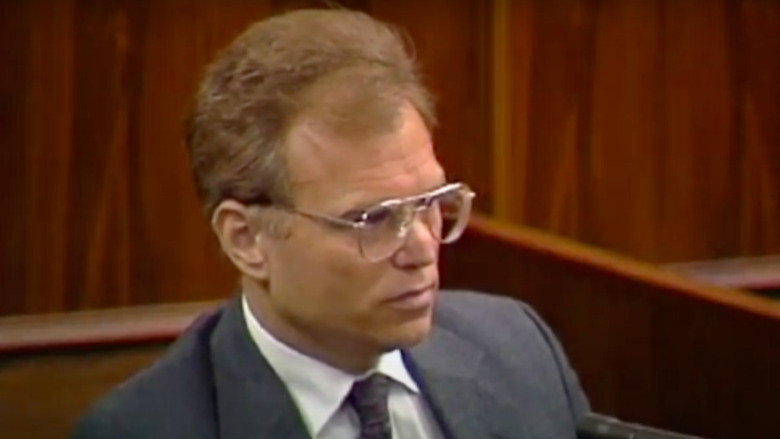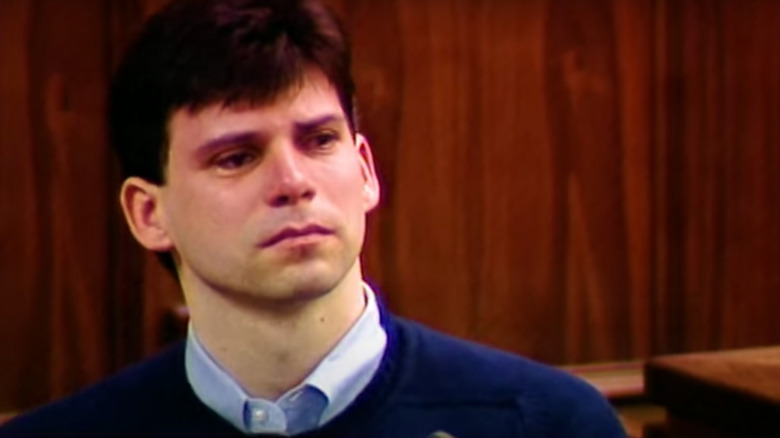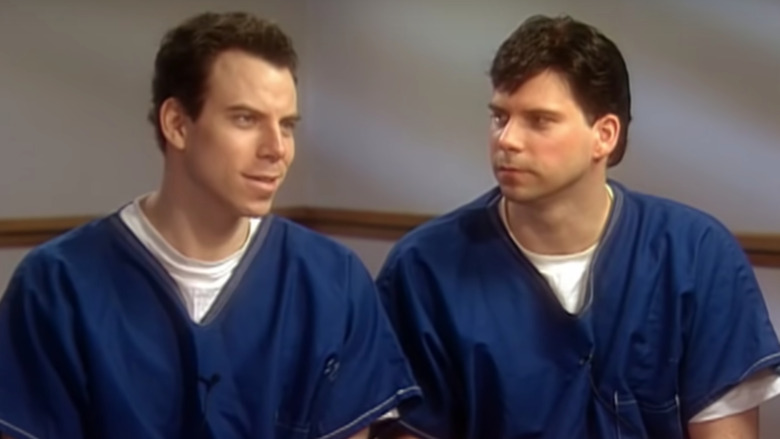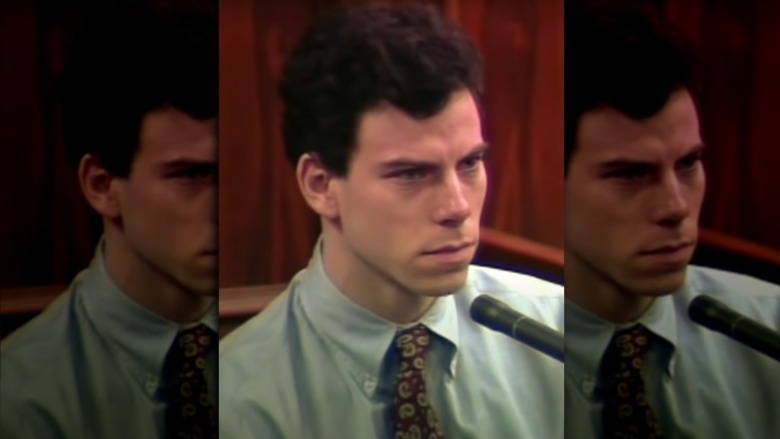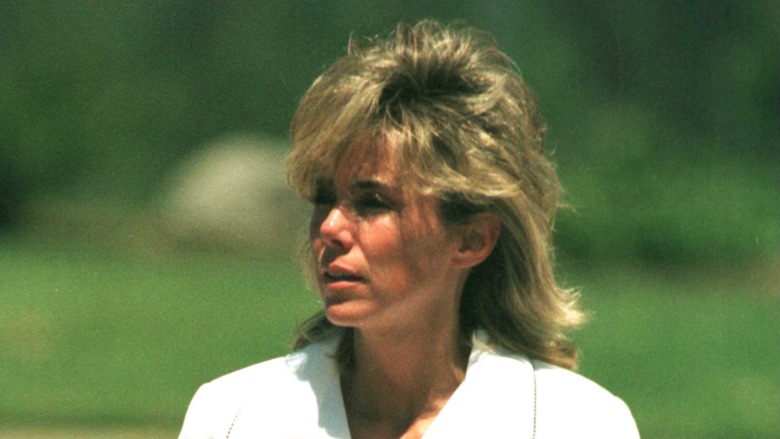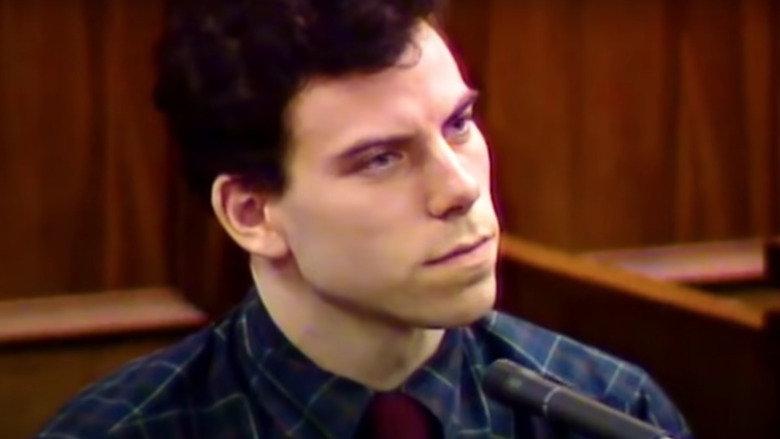The Most Bizarre Things About The Menendez Brothers Case
We may receive a commission on purchases made from links.
Wealthy brothers Lyle and Erik Menendez appeared to be living the American Dream. But on August 20, 1989, 21-year-old Lyle and his 18-year-old brother Erik killed both their parents in what became one of America's most infamous cases, inspiring documentaries, movies, and the "Law & Order True Crime" miniseries starring Josh Charles. Successful entertainment executive, José Menendez, 45, and his beauty queen wife, Mary "Kitty" Menendez, 47, were relaxing at their Beverly Hills home when their sons killed them with 12-gauge shotguns, the Los Angeles Times reported in 1993. José was shot six times and Kitty 10 times, according to Vanity Fair. The brothers left a horror scene in the mansion on Elm Drive.
Prosecutors built a case of two spoiled, rich boys who murdered their parents for the inheritance. The defense, on the other hand, portrayed Lyle and Erik as the victims of parental abuse, including emotional, physical, and even sexual. Two hung juries ended in a mistrial in 1994, sending the Menendez brothers back to court in 1996. The jury was more certain this time around and convicted Lyle and Erik of first-degree murder and conspiracy to commit murder. The judge sentenced them to life in prison without the possibility of parole. Keep reading to learn some of the bizarre facts about the case.
Were José and Kitty Menendez watching TV and eating dessert when they died?
According to Vanity Fair, José and Kitty Menendez sat side by side in their 9,000-square-foot, eight-bedroom home in Beverly Hills, eating vanilla ice cream with berries when their two sons shot them. This detail, however, was disputed in court, according to the Los Angeles Times, as it stipulated "the special circumstance of murder while lying in wait, the image of the parents enjoying such a desert [sic] would serve as a powerful suggestion of an ambush." Other reports suggested both parents were asleep when José was shot, according to People.
Prosecutor Pamela Bozanich asked Lyle Menendez if their parents had been eating dessert when he opened fire, but the judge sustained defense lawyer Leslie Abramson's objection to it. However, she went on to show him a photo taken after the crime that featured "a container with a spoon and a white substance," as the Los Angeles Times reported.
Lyle actually testified that José was standing when he began shooting, ultimately delivering the fatal blow with a point-blank shot to "the back of his father's head." Kitty Menendez, Lyle testified, was "sort of sneaking around the side of the coffee table" after being initially shot. She, too, was ultimately killed with a close range shot, "a contact wound to the left cheek, meaning she was hit with the gun muzzle against her skin," per the Los Angeles Times.
The Menendez brothers made it look like a mob hit
Lyle and Erik Menendez intended to create a crime scene that would lead investigators to suspect the murders were a mob hit. As noted by E!, the brothers shot both their mother and father in the knee to make it look like the violence was linked to organized crime. They succeeded — at least initially. Both family and law enforcement believed a possible motive could have been José Menendez's involvement in the entertainment industry. As the Associated Press reported, shortly after the murders, the name of Noel C. Bloom, the owner of José's place of employment, Live Entertainment, was added to a report on organized crime in association with the distribution "of X-rated movies." Bloom had also reportedly been close to "the late Michael Zaffarano of the Bonanno organized-crime family."
"We think he made the mistake of buying a business that had been used before by the Mafia, and we think he was trying to run it straight," said Marta Menendez-Cano, José Menendez's sister, per the AP.
However, there were indicators that went against that theory, as Vanity Fair's Dominick Dunne pointed out. Firstly, the scene was exceedingly "messy," which goes against the style of the mafia, Dunne argued. It was also unlikely that a mob hitman would have taken the time to "pick up the shell casings." Further, the mob would not have shot Kitty or used so many rounds in José's execution, Dunne concluded.
Fidel Castro was among those initially suspected of involvement in the Menendez murders
Amid widespread speculation that José and Kitty Menendez had been killed by the mafia, other possibilities were also floated, including a hypothesis that the late Cuban president and leader of the revolution, Fidel Castro, had ordered the murders. As Rolling Stone explained, his name was on a long list put together in the early days of the investigation. Lyle and Erik Menendez also suggested that was a possibility, according to Vanity Fair.
The son of a soccer player, José fled Cuba in 1960, according to People, a year after Castro's forces successfully ousted Fulgencio Batista. The government began attempting to seize his investment property shortly after ascending to power in January 1959, and José's father opted to ship his son off to the U.S. while he stayed behind to try to save it, the report detailed.
José had political aspirations and planned to run for U.S. Senate as a way to "liberate Cuba and oust Fidel Castro," according to NBC Los Angeles. Given his background, investigators briefly entertained the notion that the murders could have been linked to José's "plan to unseat the Castro regime," per Rolling Stone. "He hated Fidel with a passion," Erik said in 1989 (via People). "He wanted to spend the rest of his life getting Castro out of Cuba. He probably would've done it, and he probably would've been assassinated somewhere down the line."
The Menendez brothers came up with an intricate alibi
After shooting their parents, Lyle and Erik Menendez drove to a movie theater with the intention of buying tickets for the latest James Bond movie, "License to Kill," according to Vanity Fair. But because it was sold out, they bought tickets for "Batman" instead, a movie they had already seen, per the report. From the theater, the brothers attended the Taste of L.A. food festival in Santa Monica, according to People. Once there, they attempted to make plans to meet a friend at The Cheesecake Factory in Beverly Hills as a way to strengthen their alibi, though they couldn't reach him, the report continued.
Close to midnight, the brothers drove back home where they claimed to have found the door open. They told authorities they found their slain parents in the TV room, according to People. "I've never seen anything like it, never will see anything like it. They looked like wax. I've never seen my dad helpless, and it's sad to think he would ever be," Erik told a reporter shortly after the murders and before his arrest, per People.
Lyle called 911 and exclaimed — twice— to the operator that "Somebody killed my parents," according to a transcript published by the Associated Press in 1990. Lyle's convincing sobs heard in the tape continue to shock the public. He later claimed his emotions were real, but not from grief. "I think I was just absolutely broken down with stress," Lyle said (via People).
Lyle and Erik Menendez spent an estimated $700,000 before their arrest
After killing José and Kitty Menendez, Lyle and Erik eluded arrest for more than six months. Even though investigators suspected the sons from the get-go, their suspicion grew stronger during the following weeks and months in light of the brothers' behavior. During that time, they spent an estimated $700,000, according to Vanity Fair.
Erik bought a Jeep Wrangler to replace his Mustang and hired a tennis coach whose salary was $50,000 a year, per the report. He also invested $40,000 in a rock concert at Los Angeles Palladium, but lost the whole sum to what Vanity Fair's Dominick Dunne described as a "con-man." Among some of Lyle's lavish acquisitions were a $60,000 Porsche in place of his Alfa Romeo, clothes totaling about $40,000 and a Rolex estimated at $15,000, per the report. He also purchased a restaurant in Princeton, New Jersey, for $550,000, contending the foray into the restaurant industry was an homage to his late mother. "It was one of my mother's delights that I pursue a small restaurant chain and serve healthy food with friendly service," he said (via Vanity Fair).
The brothers moved out of their Beverly Hills mansion and into "adjoining condos" in Marina Del Rey. Erik also hired a computer specialist to erase a revised version of José Menendez's will from their home computer, on which he had been working prior to the murders, per Vanity Fair.
The Menendez brothers committed serious crimes before the murders
The murders of José and Kitty Menendez were not Lyle and Erik Menendez's first brush with the law. Two years before the 1989 crime, Lyle and Erik were involved in two criminal offenses: a burglary in Calabasas and grand theft in Hidden Hills, totaling more than $100,000 in cash, jewelry and other possessions, according to Vanity Fair. José took care of the situation by returning the money and possessions and paying "$11,000 in damages," per the report. "They were bored.... Robbing houses was a challenge.... They didn't think they'd be caught," said Karen Ferrell, a close friend of the boys' mother, during the ABC News special "Truth And Lies: The Menendez Brothers" (via Us Magazine)
Because Lyle was already 18 at the time the crimes were committed, and Erik was not, the younger brother took responsibility for the offenses, per Vanity Fair. A judge granted Erik probation and the family moved to the infamous Beverly Hills mansion, per Us Magazine. The judge also ordered Erik to receive compulsory counseling. As Vanity Fair explained, his mother asked her own therapist for a recommendation and he gave her the name of psychologist Jerome Oziel, who went on to become a key piece in the investigation and subsequent trials.
The Menendez brothers became suspects after Erik confessed to a psychologist
After the burglary incidents, Erik Menendez began seeing psychologist Jerome Oziel (above) for his court-ordered counseling. On October 31, 1989, two months after the murders of José and Kitty Menendez, Erik asked Oziel to see him and reportedly confessed his and Lyle's involvement in the crime, according to Vanity Fair. Erik told Lyle about it, who responded by threatening the psychologist with death if he reported the brothers.
Oziel didn't report them to the police, but mentioned the fact to Judalon Smyth, with whom he was having an affair, the report detailed. And she did go to the authorities, albeit almost four months after the confession had allegedly been made. During trial, Lyle's attorney, Joel Isaacson, argued the audiotapes didn't include a confession, but Oziel's interpretation of Erik's session, per the Los Angeles Times. "Most of what is on the tapes is the statements, personal thoughts and impressions of Dr. Oziel," he said.
Shortly after leaving home in his brother's Jeep on March 8, 1990, three days after Smyth reported the brothers, Lyle was arrested "by more than a dozen heavily armed Beverly Hills policemen," according to Vanity Fair. Erik had been in Israel for the previous two weeks for a tennis tournament. Instead of returning to Los Angeles, Erik flew to Miami, where he had family. An aunt urged him to fly back home and turn himself in, per Vanity Fair, which he did on March 11.
Lyle and Erik Menendez claimed their parents abused them
The Menendez brothers' first trial took place in 1993, when Lyle was 25 and Erik 22. Up until that point, the public was largely unaware of the defense team's plan. According to TruTV (via Crime Library), prosecutor Pamela Bozanich expected the defense to argue the state lacked evidence to link the brothers to the crime. But defense attorney Leslie Abramson argued that Lyle and Erik were the victims of lifelong abuse.
Abramson portrayed the Menendezes as a dysfunctional family led by a patriarch obsessed with success and status and a matriarch who was "a mentally unstable alcoholic," according to People. The defense also argued that José Menendez began sexually assaulting Lyle and Erik when they were 7 and 6, respectively, per Rolling Stone. "I had dismissed what had happened to me as something that happened to little boys," Lyle said in court, per E!.
The defense's strategy was successful. The two separate juries assigned to each brother were hung in January 1994, setting up the cases for retrial. In August 1995, the brothers were back in court to be judged by one jury. This time around, Judge Stanley Weisberg didn't allow the trial to be televised, per Rolling Stone. He also didn't allow much of the abuse and violence evidence previously presented by the defense.
The Menendez brothers based their plan on a film
Prosecutors argued that Lyle and Erik Menendez drew inspiration to carry out the murders from the 1987 movie "Billionaire Boys Club," the Los Angeles Times reported in 1993. The movie, reruns of which had been playing on NBC just a few weeks before the murders, followed a handful of wealthy Beverly Hills young men who killed two people, including the millionaire father of one of the protagonists, Vanity Fair detailed.
According to the Los Angeles Times report, the behavior of the brothers continued to mimic those of the "Billionaire Boys Club" in the months that followed. One of the movie protagonists owned a Jeep and wore a Rolex watch. Erik bought the same car as soon as he began receiving the payments from their father's insurance and, just days after the crime, both brothers bought Rolexes, per Vanity Fair. Stuart Lindner, a dressmaker and owner of an upscale store, estimated that Lyle's watch cost around $15,000, according to People.
In 1988, a year before the murders of José and Kitty Menendez, Erik co-authored a movie script with high school friend Craig Cignarelli, titled "Friends," which centered on a young man who murdered his parents for their fortune, according to a separate Vanity Fair report. The script was typewritten by none other than Kitty, per the report.
The Menendez brothers' trial was among the first to be broadcast
Lyle and Erik Menendez's trial was shown live on Court TV. As The New York Times noted, theirs was one of the "first high-profile cases to be broadcast." Global News goes so far as to argue that the televised trial gave rise to our current obsession with true crime. The trial, Rolling Stone argued, "turned real-life tragedy into live entertainment."
"It probably had the effect, maybe good, maybe bad, of demonstrating that, even if you didn't have a celebrity, if the circumstances were dramatic enough, people will be captivated," lawyer and journalist Steven Brill said (via Rolling Stone). "We've had lots of trials like that since, but that was really the one that proved that people would be interested in watching big trials."
While many believe that televising trials could negatively affect the outcome in light of the added pressure and attention, Brill believes the practice has "educate[d] the public about how the court system works," he told Rolling Stone.
Both Menendez brothers married in prison
Lyle and Erik Menendez have spent more time in prison than outside of it. But that hasn't stopped both of them from getting married. In 1996, just months after being convicted of first-degree murder, Lyle married former model Anna Erickson, but the couple divorced five years later, in 2001, according to People. Erickson began to write to Lyle near the end of his 1993 trial, she told People in a 1996 interview. "I was watching the lawyers thanking people for all these letters of support Erik got. I thought to myself, 'What about Lyle?'" she said of why she began communicating with him.
In 2003, Lyle married Rebecca Sneed. In his 2017 interview with People, Lyle described his marriage to the former magazine editor and lawyer, explaining that they try to talk on the phone daily. "I have a very steady, involved marriage and that helps sustain me and brings a lot of peace and joy. It's a counter to the unpredictable, very stressful environment here," Lyle said.
Erik has also enjoyed a long marriage in lockup. In 1999, he wed Tammi Menendez (above), who released a book about their relationship in 2005. "Tammi's love was a major step in my choosing life," Erik said (via People). "Having someone who loves you unconditionally, who you can be completely open with, is good for anybody — to know that this person loves me as I am."
The Menendez brothers have found strong support among young social media users
Pages in support of Lyle and Erik Menendez have exploded on social media, particularly on TikTok and Instagram, according to The New York Times. Y During the coronavirus pandemic, young people started binge-watching the trial, which has generated not only interest among people who weren't even born at the time of the crimes, but also "sympathy" for the brothers, the NYT explained.
Throughout the pandemic year, Robert Rand — a former reporter and believer that Lyle and Erik should have been acquitted of the crime — reported a boost in traffic to the website he runs in support of the brothers. Rand told the NYT that visits to the page jumped from 500 a day to more than 50,000 over one weekend toward the end of 2020.
The explanation for the phenomenon could come down to the way social media works, especially video-heavy platforms like TikTok, professor of media studies at Columbia College Chicago Sharon Ross explained (via NYT). Videos can be clipped and shown out-of-context in an effort to "generate reactions," she said. Also, Ross added, social media has formed a whole generation raised outside the confines of traditional news coverage, which has bolstered discussions on "big picture issues such as how we define truth, justice, and equity." In fact, the podcast "History of the '90s" questions whether our modern take on abuse and violence in the family would produce a different outcome if the trial happened today.

